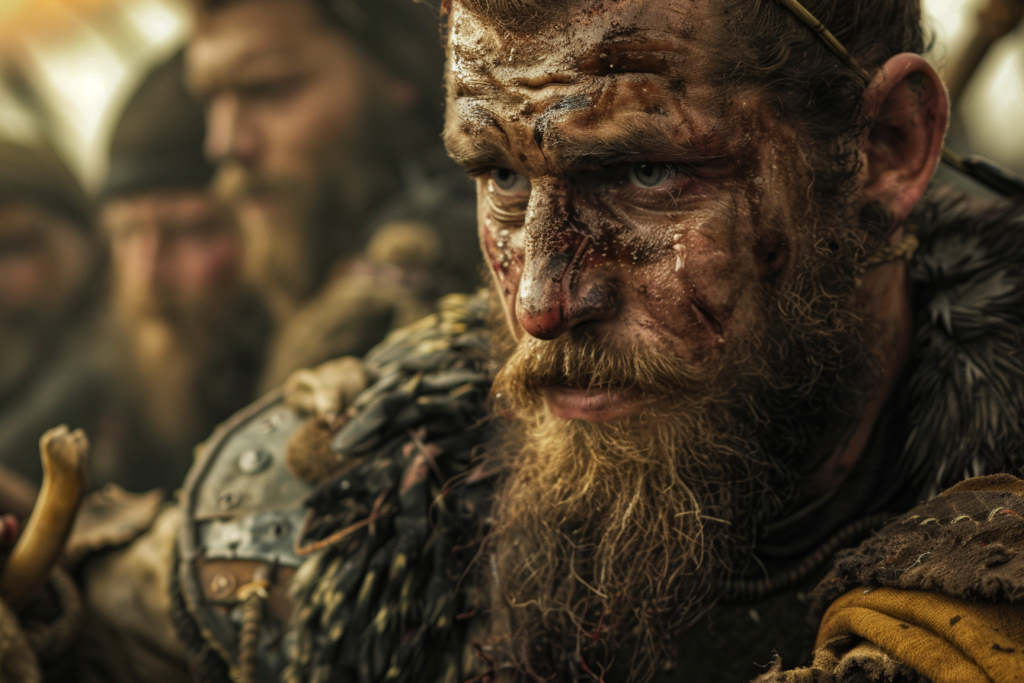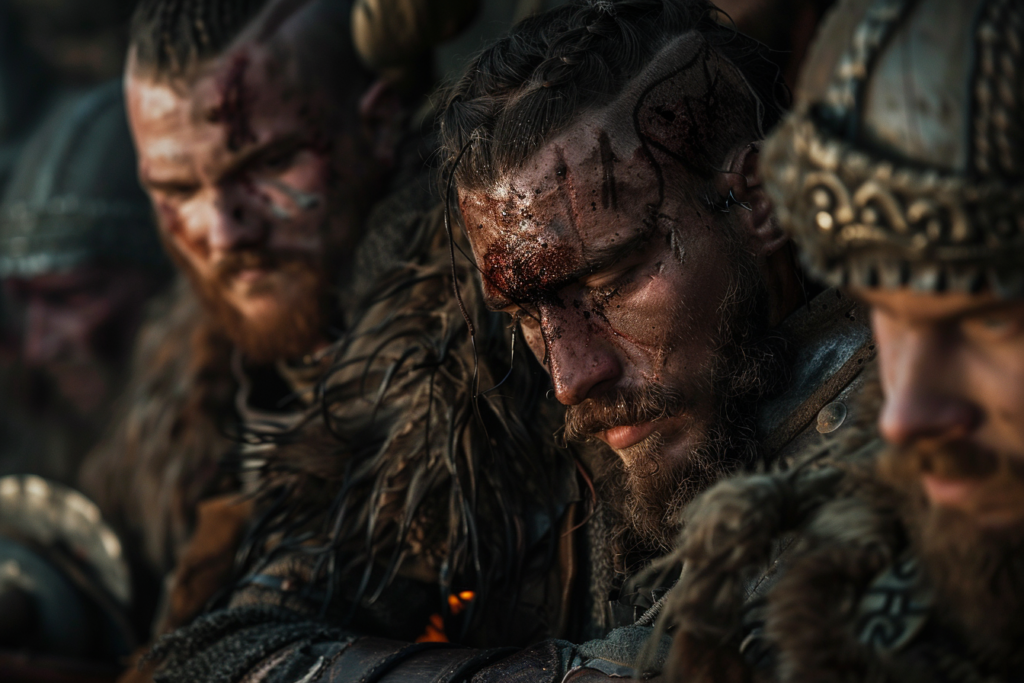Wounded Viking warriors were a common sight on the battlefield, and the methods used to care for them were often brutal and unhygienic.
Infections were a major concern, and many warriors died from complications related to their wounds.

One of the most important aspects of Viking wound care was cleanliness. Warriors were encouraged to keep their weapons and armor clean, and wounds were washed with water or vinegar to prevent infection.
In addition, many herbs and plants were used to treat wounds, including yarrow, chamomile, and comfrey. These plants were often boiled into a poultice or tea, which was then applied to the wound to promote healing.
Some warriors still died from their wounds. In some cases, this was due to the severity of the injury, but in others, it was due to infections that could not be cured.

Historical Context of Viking Warfare
Weaponry and Armor
Viking warriors were known for their superior weapons and armor, which gave them an edge over their enemies. Their weapons included swords, shields, axes, and spears.
Swords were the most prized possession of a Viking warrior, and only the wealthiest warriors could afford them. Shields were used to block attacks and were often decorated with intricate designs.
Viking armor was made of leather and chainmail, with helmets being a crucial component of a warrior’s armor. Contrary to popular belief, Viking helmets did not have horns. They were designed to protect the most vulnerable part of the body, the head.
Common Injuries in Battle
Viking warfare was brutal and often resulted in serious injuries. Common injuries included broken bones, cuts, and puncture wounds.
Infections were also a significant concern, as wounds sustained in battle were often left untreated due to the lack of medical knowledge.
The Vikings were known for their raiding and pillaging, which often involved surprise attacks on unsuspecting villages and towns.
Their heavy use of ships, good strategic mobility, and strong grasp on logistics ensured they could cause significant damage to their enemies.
Medical Practices and Wound Care

In the Viking Age, wounded warriors were tended to by healers, who used a combination of herbal remedies and surgery to treat injuries sustained in battle.
The healers were often women who had learned their craft from their mothers and grandmothers, and they had a deep knowledge of the medicinal properties of various herbs and plants.
Herbal Remedies and Ancient Medicine
Herbal remedies were a common form of treatment for wounds in the Viking Age. The healers would create poultices and salves from a variety of plants, including leeks, onions, and other herbs.
These remedies were used to reduce inflammation, prevent infection, and promote healing.
One of the most popular remedies was honey, which was used both topically and orally. Honey has natural antibacterial properties and was believed to help prevent infection and promote healing.
It was also used as a sweetener in medicinal teas and other remedies.
Surgical Interventions and Amputation
In cases where herbal remedies were not enough, surgery was sometimes necessary. The healers had a basic knowledge of surgical procedures and would perform amputations and other procedures as needed.
Amputation was a common treatment for severe injuries, such as a limb that had been badly damaged or infected.
The healers would use a variety of tools, including knives and saws, to remove the affected limb. The wound would then be cauterized to prevent bleeding and infection.
Cultural and Social Support Systems

Role of Kin and Community
In Viking society, the role of kin and community was crucial in providing support for wounded warriors. The family and community would care for the wounded warrior, providing food, shelter, and medical attention.
The kin would also ensure that the warrior’s reputation was not tarnished due to their injury.
The king would also play a role in supporting the wounded warrior. The king would provide compensation for the warrior’s injuries and ensure that they were taken care of.
The king would also ensure that the warrior’s reputation was maintained, as their reputation was crucial in Viking society.
Spiritual Beliefs and Healing
Vikings believed that the gods played a role in healing the wounded warrior. The gods would be called upon to aid in the healing process.
The warrior would also be given various herbal remedies and potions to aid in their recovery.
The community would also participate in the healing process, with the wounded warrior being surrounded by friends and family.
The community would also participate in various rituals to aid in the healing process.
Archaeological Evidence and Scholarly Insights

Skeletal Remains and Battlefield Excavations
Archaeologists have uncovered numerous skeletal remains of Viking warriors, which provide valuable insights into the nature of their wounds and the care they received after battle.
For instance, a study of skeletal remains from a Viking cemetery in Iona, Scotland, found evidence of severe head injuries, fractures, and other wounds that would have been fatal without medical intervention.
The researchers also found evidence of advanced wound care, such as the use of herbal remedies and the application of bandages and dressings.
Similarly, battlefield excavations have revealed evidence of makeshift hospitals and triage centers, where wounded warriors were treated and cared for.
For example, at the Viking Age site of Repton in England, archaeologists discovered a mass grave containing the remains of dozens of warriors, many of whom had suffered severe injuries.
The presence of medical supplies and equipment, such as scalpels, forceps, and bone needles, suggests that the Vikings had a sophisticated understanding of wound care and infection prevention.
Historical Texts and Norse Sagas
In addition to archaeological evidence, historians and scholars have turned to written sources, such as Norse sagas and historical texts, to gain insights into Viking medicine and wound care.
For instance, the Icelandic sagas contain numerous references to the use of herbal remedies. These include yarrow, chamomile, and St. John’s wort, which were used for treating wounds and infections. The sagas also describe the use of cauterization, amputation, and other surgical procedures for severe injuries.
Moreover, Norse medical texts, such as the 13th-century “Hauksbók” and the 14th-century “Norwegian Medical Book,” provide detailed instructions for treating various ailments and injuries.
These texts describe the use of poultices, ointments, and salves made from herbs, animal products, and minerals, as well as the use of bloodletting and other procedures.
The archaeological and written evidence suggests that the Vikings had a sophisticated understanding of wound care and infection prevention. They also used a variety of medical treatments and procedures to care for their wounded warriors.

![What Happened to Wounded Viking Warriors? [Wound Care and Infection After Battle]](https://historyexplained.org/wp-content/uploads/2024/05/woundedvikingbattle-1320x880.png)








Add Comment